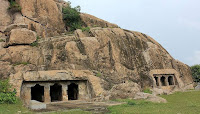THE NORTHERN CAVE TEMPLE
The northernmost cave temple in the chain of granite hills is called Mamandur I, for want of its original name which is not known. It is a small, very attractive chapel where a different layout was attempted indicating that by now the Pallava architects were familiar with the techniques and basic plans of Mahendra’s rock architecture and ventured further to realize new ideas. The simplicity here is not the austere bareness of Mandagapattu but intentional.
The basic idea obviously was to focus attention on the single shrine by projecting it from the back wall of the temple and leaving the space in front of it unobstructed by the otherwise almost obligatory second row of pillars. Thus, a small but wellproportioned empty hall was created. The projection of the shrine is further emphasized by a rounded cornice above and a moulded base below; No further ornamentation was needed for this kind of design and even the dvarapalas have been omitted here.
Into the southern wall of this hall the inscription by which the temple gained fame is carved. Though badly damaged with big pieces of granite missing here and there indicating that at least part of the mutilation was arbitrary, it is yet a unique document from which much valuable information can be gained.
The facade of the cave temple consists of two pillars and two plain pilasters at either end. The lower sadurams of the pillars are considerably higher than the top ones, the latter looking almost odd in their reduced height. The kattu in between is elongated. Into the top and bottom sadurams circular lotus medallions in a square framing are carved. The single shrine chamber is excavated well above the level of the hall and entered by the two rock-steps with the semi circular stone (chandra sila) at the bottom.
A platform with a square pit is carved from the back wall of the shrine. Traces of old paint and plaster are found all over the walls. The corbels of the pillars, for example, are decorated with painted circular lotuses against a red background, similar to the ceiling patterns in Sittanavasal. The granite of the temple is darkened and eroded and shows arbitrary mutilations in places.
The basic idea obviously was to focus attention on the single shrine by projecting it from the back wall of the temple and leaving the space in front of it unobstructed by the otherwise almost obligatory second row of pillars. Thus, a small but wellproportioned empty hall was created. The projection of the shrine is further emphasized by a rounded cornice above and a moulded base below; No further ornamentation was needed for this kind of design and even the dvarapalas have been omitted here.
Into the southern wall of this hall the inscription by which the temple gained fame is carved. Though badly damaged with big pieces of granite missing here and there indicating that at least part of the mutilation was arbitrary, it is yet a unique document from which much valuable information can be gained.
The facade of the cave temple consists of two pillars and two plain pilasters at either end. The lower sadurams of the pillars are considerably higher than the top ones, the latter looking almost odd in their reduced height. The kattu in between is elongated. Into the top and bottom sadurams circular lotus medallions in a square framing are carved. The single shrine chamber is excavated well above the level of the hall and entered by the two rock-steps with the semi circular stone (chandra sila) at the bottom.
A platform with a square pit is carved from the back wall of the shrine. Traces of old paint and plaster are found all over the walls. The corbels of the pillars, for example, are decorated with painted circular lotuses against a red background, similar to the ceiling patterns in Sittanavasal. The granite of the temple is darkened and eroded and shows arbitrary mutilations in places.







Comments
Post a Comment